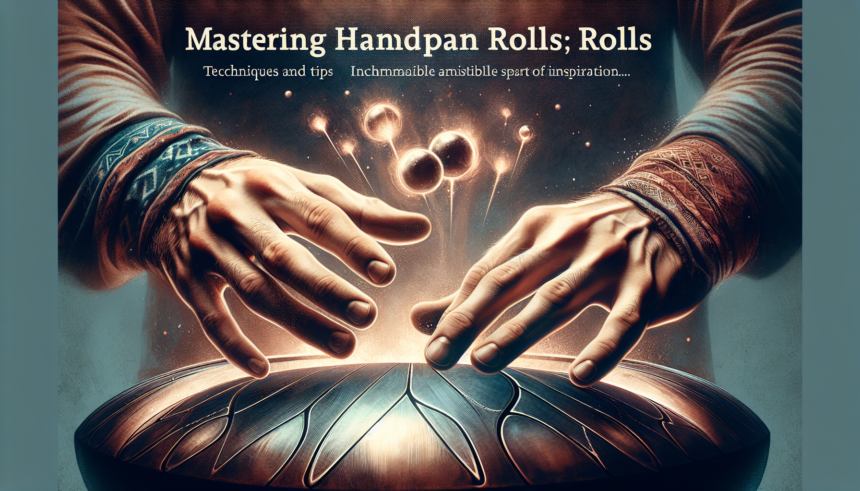Handpans have become increasingly popular in the world of music due to their unique, ethereal sound. One of the techniques that can significantly enhance your playing is the handpan roll. Mastering handpan rolls takes practice and dedication, but the results can be incredibly rewarding. This article will delve into the various techniques and tips for mastering handpan rolls to elevate your musicality and impress your listeners.
Understanding Handpan Rolls
A handpan roll is a technique where the player rapidly strikes multiple notes in quick succession, creating a smooth, flowing sound. This technique is often used to add texture and complexity to a piece of music, creating an almost hypnotic effect.
There are various types of handpan rolls, including single-finger rolls, double-finger rolls, and even multi-finger rolls. Each type has its unique challenges and advantages.
Basic Techniques
1. Single-Finger Rolls
Single-finger rolls are the simplest type of roll and are an excellent starting point for beginners. To perform a single-finger roll, use one finger to strike the notes in quick succession. Here’s how to practice:
- Start by striking a single note with one finger.
- Move to the next note quickly, using the same finger.
- Continue this pattern, gradually increasing speed.
- Focus on maintaining even pressure and timing between each strike.
2. Double-Finger Rolls
Once you are comfortable with single-finger rolls, you can move on to double-finger rolls. This technique involves using two fingers in alternation to strike the notes. It allows for a quicker and smoother roll. Here are the steps:
- Start with two fingers (usually the index and middle finger).
- Strike the first note with the index finger, then the second note with the middle finger.
- Continue alternating fingers for subsequent notes.
- Practice slowly at first, gradually increasing speed while maintaining control.
3. Multi-Finger Rolls
Multi-finger rolls involve using multiple fingers, often all on one hand, to create a complex and fast roll. This technique is more advanced and requires significant practice. Here’s how to approach it:
- Position your fingers (usually all four fingers excluding the thumb) above the notes.
- Strike the notes sequentially with each finger in a rolling motion.
- Practice the motion slowly, focusing on even timing and pressure.
- Gradually increase speed as you become more comfortable.
Advanced Techniques
1. Ghost Notes
Ghost notes are softer, subtler strikes that are used to add dynamics to your roll. They can make your playing more expressive. To practice ghost notes:
- Integrate softer strikes within your roll pattern.
- Focus on the difference in pressure between regular notes and ghost notes.
- Experiment with different combinations of loud and soft strikes.
2. Cross-Hand Rolls
Cross-hand rolls involve crossing your hands as you strike the notes. This technique can add a visual element to your performance and can also allow for more complex patterns. Here’s how to practice:
- Begin with your hands positioned normally above the notes.
- Start a roll pattern with one hand.
- Cross the other hand over the first hand to continue the roll.
- Practice the motion slowly, focusing on the coordination between your hands.
Tips for Mastering Handpan Rolls
1. Practice Regularly
Consistent practice is key to mastering handpan rolls. Set aside dedicated practice time each day to work on your rolls. Start slowly and gradually increase your speed as you become more comfortable.
2. Focus on Control
Control is crucial when performing rolls. Focus on maintaining even pressure and timing between each strike. It’s better to play slowly and accurately rather than quickly and sloppy.
3. Use a Metronome
A metronome can help you keep your timing consistent as you practice. Start with a slow tempo and gradually increase the speed as you become more comfortable.
4. Record Yourself
Recording yourself while practicing can provide valuable feedback. Listen to your recordings and identify areas where you need to improve.
5. Stay Relaxed
Tension in your hands and arms can hinder your ability to perform smooth rolls. Stay relaxed and avoid tensing up as you play.
Conclusion
Mastering handpan rolls is a journey that requires patience, practice, and dedication. By starting with basic techniques and gradually progressing to more advanced methods, you can develop the skills needed to perform smooth and expressive rolls. Remember to practice regularly, focus on control, and stay relaxed. With time and effort, you will be able to add beautiful, flowing rolls to your handpan playing, elevating your musical expression. Happy playing!
FAQs
1. What is a handpan roll?
A handpan roll is a technique where the player rapidly strikes multiple notes in quick succession, creating a smooth, flowing sound. It is used to add texture and complexity to a piece of music.
2. What are the different types of handpan rolls?
There are several types of handpan rolls, including single-finger rolls, double-finger rolls, and multi-finger rolls. Each type has its unique challenges and advantages.
3. How can I improve my handpan roll technique?
To improve your handpan roll technique, practice regularly, focus on maintaining even pressure and timing, use a metronome, record yourself, and stay relaxed while playing.
4. What are ghost notes in handpan rolls?
Ghost notes are softer, subtler strikes used within a roll pattern to add dynamics and expression to your playing. They help make your rolls more expressive and interesting.
5. How can I practice cross-hand rolls?
To practice cross-hand rolls, start with your hands positioned normally above the notes, begin a roll pattern with one hand, and then cross the other hand over the first hand to continue the roll. Focus on coordination between your hands.





